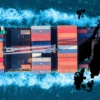So, you’re an ambitious Nordic brand, well established in your home market and looking to expand across the European continent? I don’t blame you. The size of the opportunity alone should be enough to convince you. The combined European apparel market is more than 18 times the size of the Nordic market alone and includes some of the most lucrative individual apparel markets in the world, such as the UK, France and Germany.
I’ve seen many of my clients successfully transition from a Nordic-only brand to a European powerhouse. But when you’re at the beginning of this journey, the number of unknowns can be daunting: Do I need to outsource my logistics? Will an expansion affect the quality of my customer service? When is the right time to think about expanding my business? That’s why I’ve put together this guide, based on my years of experience helping Nordic fashion brands like yours to expand across Europe. I hope you find it useful!
Question #1: When should I centralise my logistics operations?
When I discuss this with clients, I always start with the notion of ‘tipping points’. Only you will know what yours are, but I can give you some guidelines to inspire your thinking. As a general rule, if you do at least half of your business outside the Nordic region, it’s time to consider moving your logistics operations to a more central location. This is an important tipping point because the cost to your business of keeping your logistics in the Nordics may start to outweigh the potential cost of centralising your European operations.
Of course, this decision depends heavily on your customer base. For example, if your fastest-growing segment is French women and you simply can’t get enough product to them to meet demand, then a more centralised logistics operation is a no-brainer. It’s all about looking at your growth trajectory and determining when investment in your logistics will have the most impact. Do it too soon, and the cost may not be justified, but wait too long and you risk losing your competitive edge. Considering the below additional factors may help bring clarity.
Question #2: Where should I move my logistics operations?
If you do decide that it’s the right time to move your logistics operations to a more central location in Europe, the next question is where. In my opinion, it’s got to be the Benelux region, which includes Belgium, the Netherlands and Luxembourg. This region is well known as a multimodal logistics hub, with some of the best infrastructure and transport links in Europe. This enables unparalleled delivery times, even to the Nordic countries. Indeed, there’s no need to worry that moving your logistics to the Benelux region will mean compromising on delivery times to your existing Nordic customers. You can still achieve fast delivery to the Nordics from a Benelux-based distribution centre.
Clients sometimes ask me why the Benelux is better than, say, Germany, which is geographically more central. My answer is to show them logistics industry rankings. The Benelux’s high-quality, integrated transport infrastructure – by road, rail, sea and air – puts it head and shoulders above its neighbours. The Netherlands tops the DHL Global Connectedness Index, closely followed by Belgium and Luxembourg.
This exceptional level of connectivity gives you a huge advantage in terms of supply chain resilience. That’s because shipping from the Benelux region gives you much more flexibility than shipping from the Nordics. The wide variety of transport options available makes it much easier to respond to supply chain disruptions, ensuring that your customers across Europe benefit from a more consistent level of service.
Question #3: Will centralising logistics lead to a loss of control?
A common concern when I’m discussing the possibility of moving brands’ logistics operations from the Nordic region to the Benelux region is the impact of the distance. Does moving 1,500 kilometres from Stockholm to Grobbendonk in Belgium mean that you lose oversight of your distribution network? It can certainly feel like a big risk. How can you ensure that all your customers – including those in the Nordic region – continue to benefit from the highest level of customer service? Will you still be able to use your preferred last-mile carriers?
In many cases, you can continue to use your preferred carriers. A good third-party logistics (3PL) provider will usually have several existing relationships with different carriers across Europe. This means you can benefit from a dedicated logistics solution for each market you serve, rather than settling for a one-size-fits-all solution. A key part of the client onboarding process is selecting the right carriers for each market in terms of delivery speed, cost efficiency and sustainability. So, you can stick with the same carriers if you’re happy with the service you’re getting, or you can explore alternative options. The choice is yours!
Another factor to consider when choosing a carrier is delivery methods. Consumers in different markets like to receive their parcels in different ways. For example, we know that ‘buy online, pick up in-store’ (BOPIS) is more popular in France and Sweden. However, consumers in the UK, Germany and the Netherlands prefer home delivery. So, for some countries, you might lean towards the carrier with the most collection points. For others, you would be more likely to choose the carrier that offers better home delivery. Working with a 3PL can give you more – not less – control over the customer experience.
And when you add returns to the equation, the benefits of optimising each leg of the logistics journey by market become even clearer. For example, while speed may be critical for the carrier you use to ship products to customers, it’s not as important for returns. This means that you may want to use a different (cheaper) carrier to handle returns than the one you use for outbound shipments. If you only work with one carrier, this kind of flexibility is impossible. But collaborating with a well-connected 3PL gives you the ability to choose exactly the right carrier for each market and stage of the logistics cycle. In the medium and long term, this agile scalability can lead to significant savings as your brand grows across Europe.
Question #4: How will centralising logistics operations affect my brand’s sustainability profile?
One of the biggest arguments for centralising your logistics operations as your brand grows is sustainability. If your customers are increasingly concentrated outside the Nordic region, it makes sense to move your main distribution centre closer to them. This will reduce the total number of kilometres travelled. For example, let’s say you’re a fashion brand with logistics operations based outside Stockholm that ships a top to a customer in Dortmund, Germany. That’s over 1,300 kilometres. And if you include a return, that’s over 2,600 kilometres.
However, if you ship from a fulfilment centre in Almelo, the Netherlands, the distance is only 170 kilometres. This can make a huge difference to your carbon footprint as your customer base in Europe grows. Benelux-based fulfilment is also better from an inventory management perspective. For example, one of our clients makes their products in Turkey, and they used to have to fly them to their fulfilment centre in Sweden. But by relocating their logistics operations to the Benelux region, they could switch to road transport, a less polluting option.
Working with a 3PL also allows you to choose more environmentally friendly transport options. As part of Bleckmann’s Local Heroes last-mile delivery concept, we have access to more than 100 different delivery services. Many of these use greener transport methods, such as bicycles and electric vehicles. One of these delivery innovators is the Swedish company, Budbee, which is a big hit with many of our Nordic-based clients. Bleckmann also offers a range of plastic-free packaging options to help make deliveries greener.
Question #5: What’s next?
I hope this blog has clarified a few things about the potential next stage of your brand’s growth journey. The key message I want to get across is that you shouldn’t let doubt hold you back. Whether you have questions about geographical distance, customer experience or environmental credentials, it’s always better to ask. And at Bleckmann, we’re here to help. So, if your brand is looking for a more efficient way to expand across Europe, why not get in touch with one of our experts? We’ll be happy to discuss the options with you.














